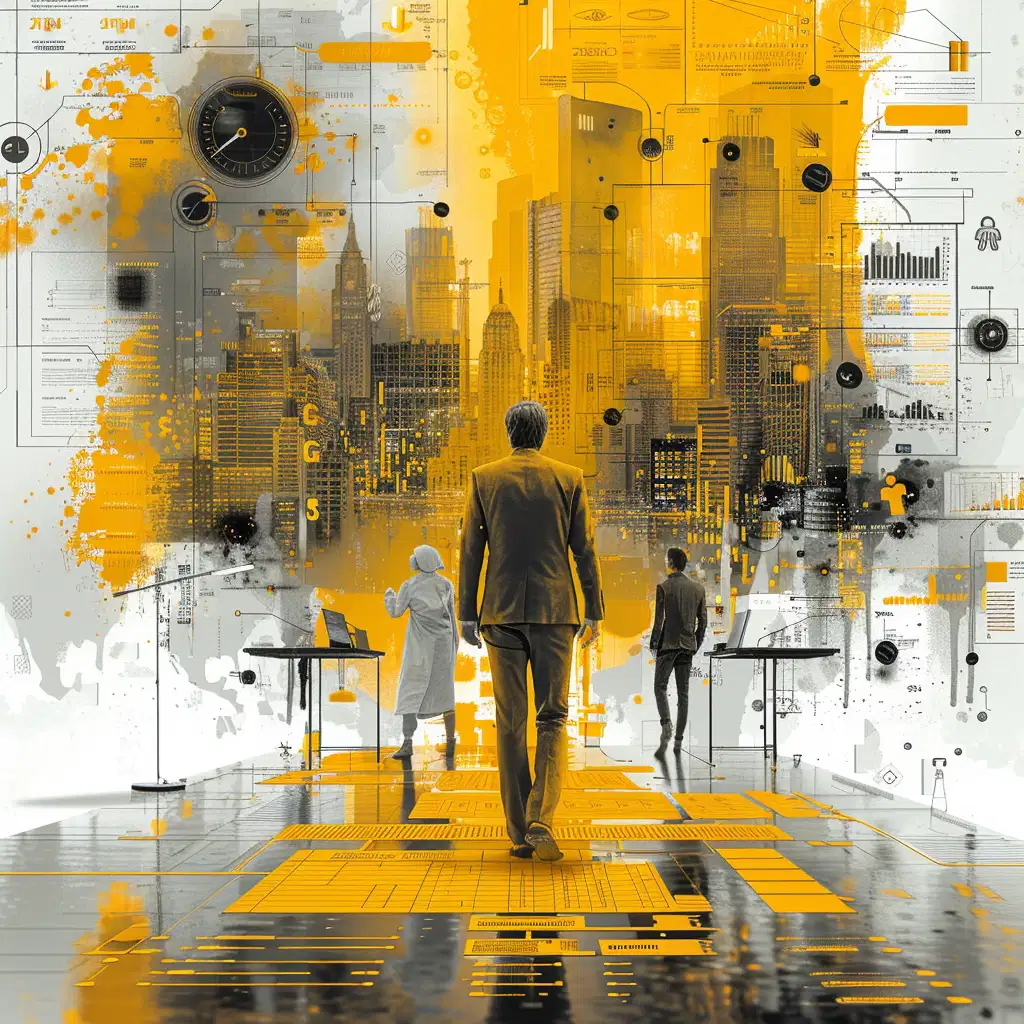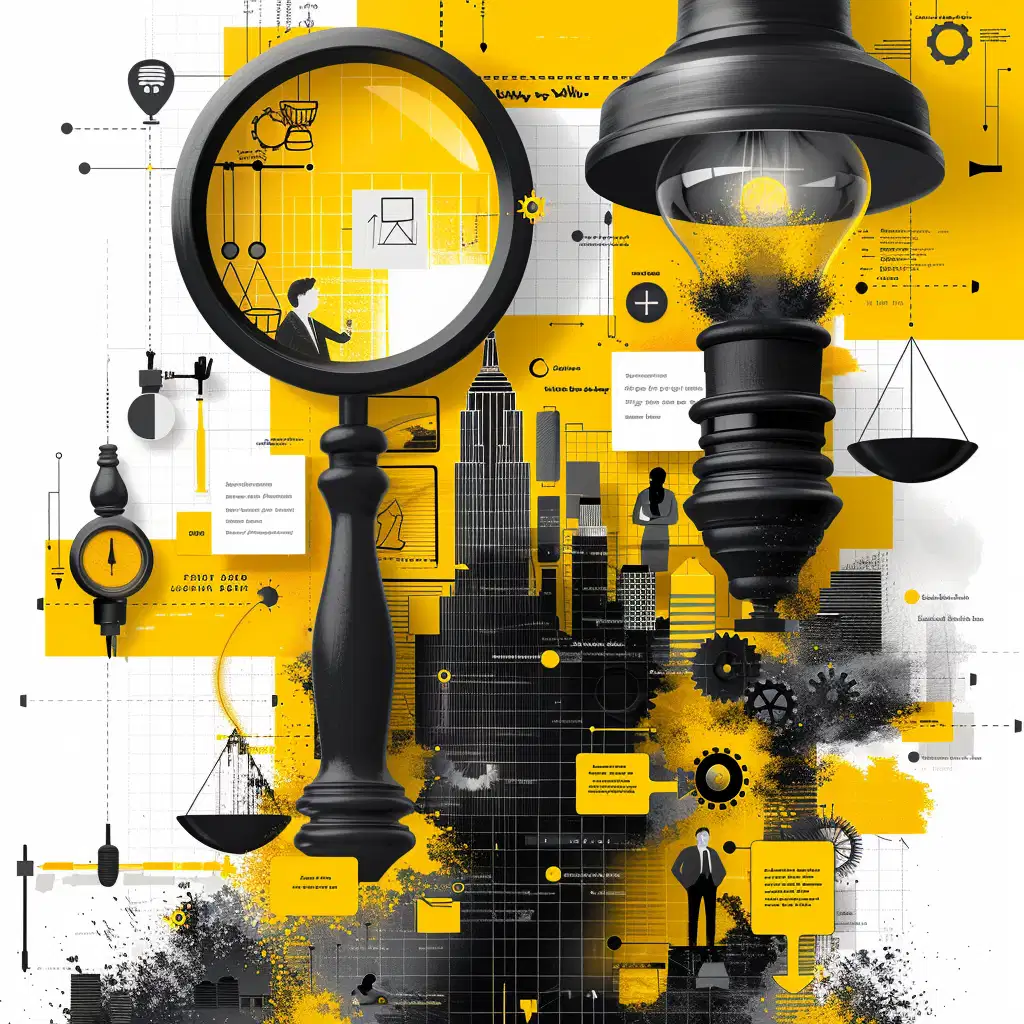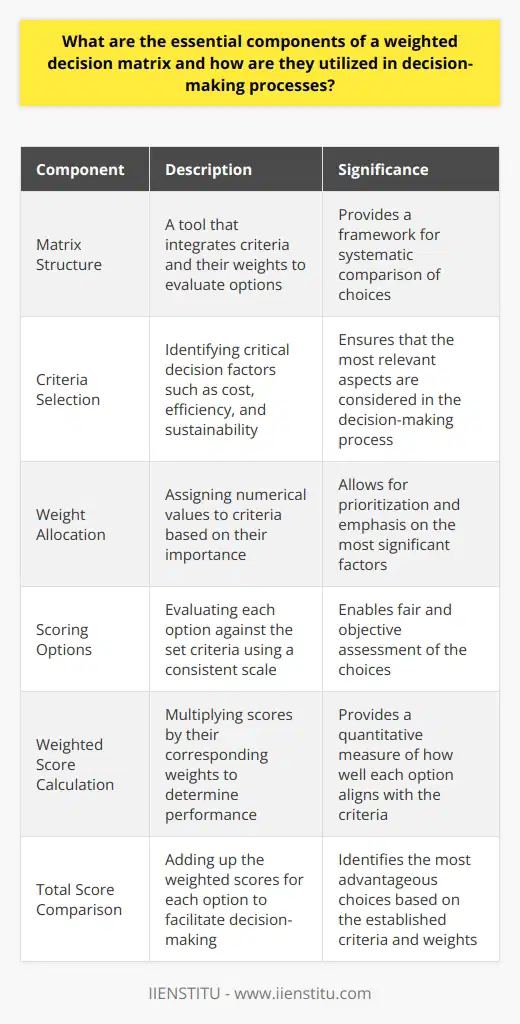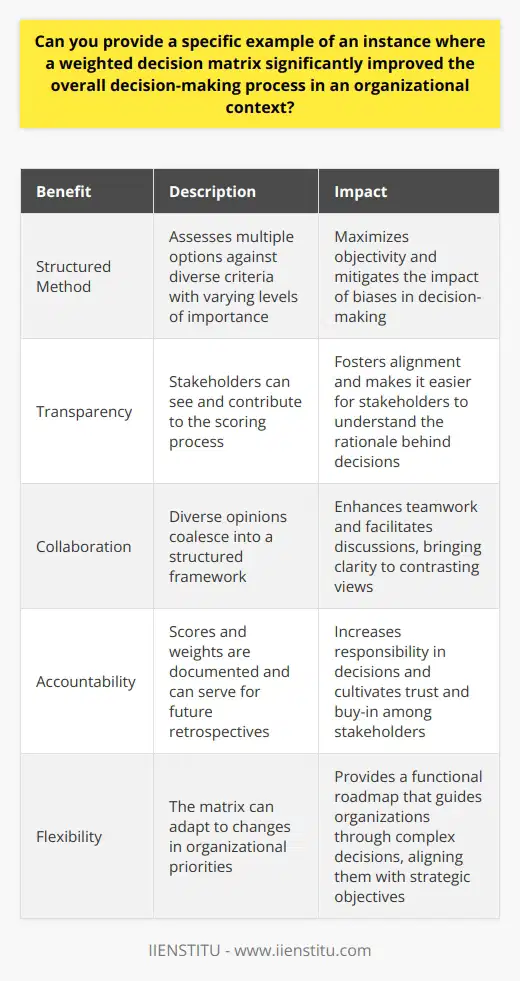
In the realm of effective decision-making strategies, the Weighted Decision Matrix (WDM) stands out as a significant tool that supports individuals and organizations in making well-measured choices. Understanding how to prioritize and logically analyze diverse options is at the core of strategic problem-solving. Whether it's choosing the right supplier, selecting a new piece of technology, or deciding upon the direction of policy, a WDM serves as a methodical approach that can provide clarity and minimize the ambiguity that often surrounds complex decisions.
The exploration of the Weighted Decision Matrix here aims to dive into the nuances of using this tool strategically. With a focus on explaining its utility and offering recommendations for its effective use, this article hopes to provide readers with the essential insight that could be equivalent in depth and practicality to that provided by an online certificate course or a problem solving techniques course.
Definition of a Weighted Decision Matrix
The Weighted Decision Matrix, also known as a prioritization matrix or a decision grid, is a quantitative tool used to evaluate various alternatives against a set of criteria deemed important for the decision at hand. Essentially, this matrix is a tabular representation where rows often represent the alternatives, while the columns represent the various factors influencing the decision. Furthermore, each factor is assigned a weight reflecting its relative importance, which ensures that the decision matrix aligns with the priorities and values of the decision-maker.
Utility and Purpose of a Weighted Decision Matrix
The primary utility of a WDM is to provide a systematic and transparent method for decision making. It turns decision paralysis into action by converting qualitative judgments into quantifiable data. The purpose of a WDM is not only to reveal the most advantageous option but also to provide a record of the decision-making process. This aids in accountability and provides a valuable point of reference for future decisions.
Core Concepts of a Weighted Decision Matrix

Decision Factors: Explanation and Significance - The decision factors in a WDM play a crucial role as they are the dimensions or criteria against which each option will be ranked. Factors must be comprehensively identified and reflect all aspects of the decision scenario. Their significance lies in the fact that they act as benchmarks that facilitate the comparison of alternatives on a consistent basis. It is imperative that these factors are relevant and significant to the decision context to avoid misguidance in the overall analysis.
Weight Assignments: Importance in Decision Making - Weights are indicative of the relative importance of each decision factor. Assigning weights is a critical step which should be accomplished with strategic forethought. Weights usually sum to a total of 100% or a similar consistent value, representing the entire scope of the decision criteria. They act as multipliers, enhancing the effect of scores on the overall decision, which is especially important in distinguishing among factors that do not equally contribute to the final outcome.
Scoring System: Description and Application - Scores are attributed to each alternative for each decision factor. The scoring system often uses a numerical range, for example, 1 to 10, where higher numbers signify better alignment with the decision criteria. The application of scoring must be conducted judiciously, with adequate knowledge and unbiased judgment, to each option as these scores will ultimately be adjusted by the weights to provide a final comparative metric across all alternatives.
Calculation and Analysis: Understanding the Result - Calculation in a WDM is straightforward: multiply scores by their respective weights and sum them to get a total score for each option. The alternative with the highest total score is deemed to have the best overall alignment with the defined criteria and weights. This process allows for a varied, multifaceted set of options to be compared on a singular scale of preference or suitability.
Real-life Example to Illustrate Core Concepts - A real-life example of utilizing a WDM could be in the selection of a new software solution for a company—the decision factors might include cost, user-friendliness, compatibility with existing systems, and customer support. After determining the weights for these factors based on their relevance to the business’s needs, each software option would be scored against these factors. Analyzing the calculated scores would give a clear indication of which software aligns best with the company’s priorities.
Benefits and Limitations of Weighted Decision Matrix

Advantages of Using a Weighted Decision Matrix
Objective Decision Making: One of the primary benefits of using a WDM is the introduction of objectivity into the decision-making process. By relying on an established set of criteria and corresponding weights, subjective biases can be reduced, making the process more transparent and justifiable.
Prioritization of Choices: WDM's systematic approach allows decision-makers to prioritize options based on quantified data. This prioritization helps in the allocation of resources, be it time, money, or manpower, to the most advantageous alternatives.
Transparency and Clarity: When decisions are made using a WDM, the rationale becomes clear and transparent to all stakeholders involved, aiding in buy-in and reducing subsequent resistance to implementation.
Limitations of a Weighted Decision Matrix
Subjectivity of Weighing and Scoring: Despite its objective façade, WDM cannot completely eliminate subjectivity. The assignment of weights and scores can still reflect personal biases or misunderstandings of the decision context.
Dependence on Prior Knowledge and Experience: The effectiveness of a WDM is contingent upon the decision-maker’s understanding and experience. A lack of comprehensive knowledge about the alternatives or criteria could lead to skewed results.
Complexity for Large, Multifactorial Decisions: For decisions that involve a multitude of factors and options, a WDM can become unwieldy and complex. This might necessitate an initial round of simplification or filtering to make the matrix manageable.
Practical Examples of Benefits and Limitations
A WDM can be highly beneficial in assessing the environmental impact of different project proposals, providing a clear objective ranking based on various environmental criteria. Conversely, in complex scenarios like urban planning, where social, economic, environmental, and political factors intertwine, the limitations of a WDM become more pronounced, requiring a comprehensive approach that may go beyond the simplicity of a singular matrix.
Various Applications of the Weighted Decision Matrix

Use in Business Decision Making: In business, a WDM is employed in scenarios ranging from vendor selection to product feature prioritization or investment appraisals. It establishes an objective framework enabling managers to make decisions that are in line with strategic business objectives.
Application in Engineering and Technology: Engineers frequently use WDMs during the design phase of products or processes to evaluate different design alternatives or material choices, integrating both technical specifications and economic considerations into one evaluative process.
Role in Health and Medicine: In healthcare, decision matrices assist in policy formulation and clinical decision protocols, where patient outcomes, cost implications, and treatment efficacy must be weighed concurrently.
Significance in Environmental Policy Making: Environmental policy often requires a balance between development and conservation. A WDM aids in such decisions by quantifiably assessing the impact of various policy options against environmental criteria.
Practical Examples of Usage in Various Domains: A WDM can be applied to prioritize research and development projects, assess the cost-benefit of green technologies, or evaluate the risk management strategies of an organization. By doing so, it streamlines decision-making processes that could otherwise be overwhelmed by complexity and subjectivity.
Recommendations for Efficiently Using a Weighted Decision Matrix

Understanding Decision Context: An in-depth understanding of the context in which a decision is to be made is fundamental. This insight informs the relevancy of criteria and the appropriateness of the weighting, underlining the need for thorough research and consultation for each decision scenario.
Clear Definition of Factors and Weights: Defining factors and determining their weights are key steps that should be conducted with precision and consideration. Involving multiple stakeholders can aid in deriving a balanced view on which factors hold more significance over others.
Balanced Scoring System: The scoring system should be balanced and consistent. Each criterion must be assessed on the basis of reliable information, and scoring rules should be established upfront to avoid inconsistency during evaluation.
Comprehensive Review of Output: Following the calculation of scores, an introspective review of the output should be performed. This involves questioning the results, examining outliers, and ensuring that the conclusions drawn from the WDM make practical sense in the real world.
Conclusion
Recap of the Weighted Decision Matrix: The exploration of the Weighted Decision Matrix underscores its effectiveness as a strategic tool for decision-making. The facets ranging from defining criteria to assigning weights, applying a scoring system, and interpreting the results have been examined to illustrate a way forward for meticulous and informed choices.
Importance and Viability in Different Fields: The versatility of the WDM is apparent in its application across multiple disciplines—from business and technology to healthcare and environmental policy-making. Its utility in enhancing clarity, transparency, and objectivity in decisions is undeniable.
Encouragement for Appropriate and Effective Use: Implementing a WDM should be done with care, with a true understanding of its strengths and limitations. When used appropriately, it can greatly enhance the quality of decision-making processes and outcomes. It is encouraged that decision-makers in all fields consider its adoption where viable, perhaps even formalizing the skill set through targeted learning, such as attending online certificate courses focused on strategic decision making or problem solving techniques courses to deepen their mastery in this domain.
Frequently Asked Questions
What are the essential components of a weighted decision matrix and how are they utilized in decision-making processes?
Weighted Decision Matrix Fundamentals
Understanding the Matrix Structure
A weighted decision matrix stands as a tool. It aids in evaluating options. Users compare choices based on several criteria. These criteria have different levels of importance. Thus, they receive weights. The matrix design integrates both the weights and the criteria.
Criteria Selection and Weight Allocation
Deciding on criteria is crucial. These criteria should reflect critical decision factors. Examples include cost, efficiency, and sustainability. Weights show the significance of each criterion. They are usually numerical. The sum often equals 100 or 1, for easier comparison.
Scoring Each Option
Once criteria and weights are set, scoring begins. Options receive scores per criterion. Typically, this scoring uses a consistent scale. For instance, 1 to 5 or 1 to 10. Consistency in scoring is key. It ensures fair assessment across all options.
Multiplying Scores by Weights
Scores then multiply by corresponding weights. This step calculates a weighted score. It signifies an option's performance in a single criterion. High scores suggest a strong match between the option and the criterion.
Totaling Scores for Decision Making
Each option's weighted scores add up. The sum is its total weighted score. Comparison across options now becomes simpler. Decisions align with the highest total scores. They should reflect the most advantageous choices given the set criteria and weights.
Review for Informed Decision Making
A thorough review completes the process. Decision makers examine the matrix for insights. They seek a deeper understanding of each option's strengths and weaknesses. The matrix should guide but not dictate. Final decisions take into account the matrix alongside context and judgment.
Utilization in Decision-Making Processes
Prioritizing Objectives
The weighted decision matrix helps prioritize. Users define what matters most. They apply focus where it is due. Prioritization becomes systematic. It reduces the risk of overlooking key aspects.
Balancing Subjective and Objective Inputs
This tool balances the subjective with the objective. Numbers give form to preferences. They allow a structured comparison. Subjectivity exists in weight allocation. However, the overall process gains objectivity through numerical scoring.
Enhancing Transparency
The matrix provides transparency. Each step is explicit. Stakeholders follow the logic. They see why decisions emerge as they do. This transparency fosters trust and confidence in outcomes.
Facilitating Group Decision Making
Groups benefit from the matrix. It directs discussions. Scores and weights offer a common ground. Team members collaborate on criterion importance. They converge on perceptions of each option's value. It streamlines decision-making in group settings.
Supporting Consistency
A final key utilization is in ensuring consistency. Decisions across different scenarios maintain a standard approach. This consistency helps maintain strategic alignment. It builds reliability into the decision-making framework of organizations.

How does the concept of weighting in a decision matrix influence the overall outcome of strategic decisions?
Understanding Weighting in Decision Matrices
Weighting plays a pivotal role in decision matrices. It provides a systematic approach to evaluating options. Decision makers assign value to individual factors. These factors differ in importance. Weighting quantifies this variable importance.
The Mechanism of Weighting
Each criterion receives a weight. Weights reflect priority levels. Higher weights signify greater importance. These weights affect overall scores.
Breaking Down the Strategic Impact
Strategic decisions hinge on accurate assessments. Weighting modifies outcomes. It steers focus to critical areas. Informed decisions emerge from this focus.
- Factor identification is essential.
- Weights allocation follows.
- Strategic alignment guides weight distribution.
The Decision Making Process
The decision matrix streamlines complex choices. We begin with criteria listing. We associate weights with each criterion. Matrix completion involves option scoring.
Weighting: The Differentiator
Without weighting, all factors stand equal. This equality rarely matches real-world scenarios. Weighting introduces nuance. It acknowledges degrees of significance.
- Some factors trump others.
- Weighting respects this hierarchy.
- It adjusts scores accordingly.
The Outcome: A Tilted Balance
Weighted scoring tilts decision making. It favors options excelling in key areas. Weighting can decisively shift rankings. It often crowns a strategic choice.
Weighting and Subjectivity
Subjectivity can taint weighting. Strategic goals drive these subjective choices. Biases and perceptions influence them as well.
- Vigilance during weight assignment is crucial.
- Checks and balances reduce bias.
- Cross-functional team input can enhance objectivity.
Decision Matrix: A Tool for Prioritization
The decision matrix acts as a prioritization tool. It lays bare the foundation of strategic choices. Weighting transforms it into a sharp instrument.
- Priorities crystallize through weighting.
- Options compare against strategic aims.
- Clear winners often emerge from this process.
Final Thoughts on Weighting
Weighting’s influence extends far beyond mere numbers. It embodies an organization's strategic vision. It is integral to making informed decisions.
- Weighting enforces discipline.
- It demands rationality.
- It imposes strategic direction.
In essence, the weight applied in a decision matrix doesn't just influence the outcome. It often defines it.

Can you provide a specific example of an instance where a weighted decision matrix significantly improved the overall decision-making process in an organizational context?
The Benefits of a Weighted Decision Matrix
A weighted decision matrix offers a structured method. It maximizes objectivity in decision-making. The tool assesses multiple options against diverse criteria. These criteria have varying levels of importance. The matrix amplifies the objectivity of the process. It aids in mitigating the impact of biases.
A Case in Organizational Decision-Making
Consider a corporation selecting new software. The decision was complex. Many stakeholders had to concur. A weighted decision matrix became instrumental. It defined key software decision criteria. Examples include cost, usability, and support. Each was assigned a weight reflecting its importance.
The team identified potential software options. Each option was then scored against the criteria. The scores were multiplied by the criteria weights. Aggregate scores yielded a quantitative assessment.
The Outcome
The matrix facilitated discussions. It brought clarity to contrasting views. Stakeholders explored their biases. They considered their preferences objectively. The matrix offered a transparent comparison. It was between functionality and Total Cost of Ownership (TCO). A consensus emerged. The best software was not the cheapest. Rather, it was the one offering the highest combined value.
The decision matrix improved the process significantly. It allowed a multifaceted evaluation. Prioritization of criteria aligned the selection. It matched the organization's strategic goals. The visualization of decisions fostered alignment. Stakeholders found it easier to understand the rationale. Agreement was reached with less resistance. The deployment of the chosen software progressed smoothly.
Key Factors in Weighted Decision Matrices
Transparency is a core benefit of a weighted decision matrix. Stakeholders see the scoring process. They can challenge and contribute to it. Collaboration is enhanced. Diverse opinions coalesce into a structured framework.
Accountability in decisions increases. Scores and weights are documented. They can serve for future retrospectives. The matrix avoids the "because I said so" scenario. Decisions are made with traceable logic. This cultivates trust and buy-in.
Flexibility is another strength of the matrix. It can adapt to changes in organizational priorities.
In Summary
A weighted decision matrix can transform decision-making. It changes it from subjective to structured. It incorporates quantitative and qualitative evaluations. The decision-making process evolves. It becomes transparent, collaborative, and accountable. A matrix provides a functional roadmap. It guides organizations through complex decisions. The matrix aligns these decisions with strategic objectives.



